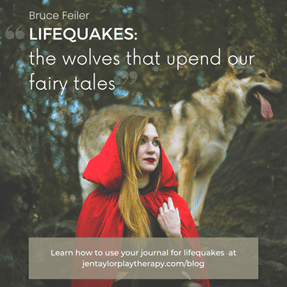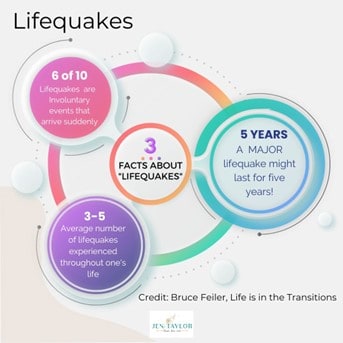Life is a journey full of unexpected twists and turns, often leading us into storms we never anticipated. These major life events, which "Life Is in the Transitions," author Bruce Feiler aptly coined as "lifequakes," can be viewed as “the wolves that upend our fairy tales.”

Lifequakes leave us feeling stuck as we try to figure out what to do in the midst of chaos or how to recover from life as we knew it to be. As a play therapist specializing in trauma, there are several transformative tools to help manage lifequakes including expressive arts like sandtray, art-making or journaling that help individuals process and navigate through these challenging times.
This post explores how to think about life-changing transitions and how to use journaling as a therapeutic tool to enhance the strengths and resources that you possess to help you through these challenging times.
Understanding Lifequakes:
Lifequakes are major disruptions in our lives that often occur unexpectedly and are largely unchosen.
Examples of lifequakes include:
- Job loss, illness, personal losses, relationship endings, financial setbacks, and natural disasters.
- Medical issues, deaths and personal losses, and relationship endings are some of the most common and disruptive
- Major traumatic events (combat, abuse/neglect, experiencing violence)
- These can also be societal changes, such as movements like Black Lives Matter or political changes like the Tea Party.
The Frequency and Impact of Lifequakes

Some disruptions to our lives are actually really normal. These smaller disruptions happen with relative frequency, but do not always create total chaos - we might recover from them within a few weeks or months.
But in about 1 of every 10 disruptions, there is a MAJOR lifequake - something from which recovery feels impossible. And, Feiler’s research has shown that these major lifequakes - the really earth-shattering ones - happen 3-5 times throughout our lifetime.
And (deep breath, here), they can last five years or longer.
Bruce Feiler says: "If you consider that we go through three to five lifequakes in our adult lives, and each one lasts four, five, six years, or longer, that could be thirty-plus years we spend in a state of change. That's half a lifetime!"
Embracing Unpredictability: Navigating Lifequakes with a Skillful Approach
The most important feature of lifequakes is their unpredictability. Unlike a plateau that can be anticipated or planned for, lifequakes often catch us off guard. This means that rather than trying to predict when a lifequake will occur, it is more valuable to develop a general toolkit for managing and navigating through unwanted change.
The goal is to actually begin to normalize that major disruptions are not surprising - we can’t look forward to them with anticipation - but we can accept that they will happen. As psychologist/economist, Daniel Kahneman says, "The correct lesson to learn from surprises is that life is surprising." And rather than blaming or shaming ourselves for not being able to prevent these surprises, we can learn how to use our specific character strengths and resources to manage them as best as possible. We can review the ability to respond to transitions as a skill. And according to Feiler, "they're a skill we can, and must, master."

"Life transitions are a skill," Bruce Feiler writes. "They're a skill we can, and must, master."
We can focus our energy on developing the skills and tools necessary to navigate through the challenges that arise. This includes cultivating emotional resilience, seeking support from others, utilizing coping strategies, and maintaining self-care practices. By embracing life transitions as an opportunity for growth and personal development, we can approach them with a sense of empowerment and proactively adapt to the changes they bring.
Seeking Support and Resources During Transitions:
If you find yourself overwhelmed by a lifequake or transition, it is important to seek support. Reach out to mental health professionals, therapists, or counselors who specialize in trauma and resilience. They can provide guidance and help you develop coping strategies tailored to your unique needs.
Additionally, various organizations and support groups are dedicated to assisting individuals facing trauma and major life events. Consider exploring resources such as:
- EMDR International Association (EMDRia) - Offers information and resources on Eye Movement Desensitization and Reprocessing (EMDR) therapy, which can be effective in trauma processing. [Website: https://www.emdria.org/]
- The Association for Play Therapy - Provides resources and information on play therapy, a therapeutic approach that can be beneficial for trauma processing, particularly in children. [Website: https://www.a4pt.org/]
- National Alliance on Mental Illness (NAMI) - Provides education, support, and resources for individuals and families affected by mental illness. [Website: https://www.nami.org/]
- American Psychological Association (APA) - Offers information, articles, and directories to help individuals find qualified therapists in their area. [Website: https://www.apa.org/]
- Trauma Resource Institute - Provides trauma-informed care and training for individuals, communities, and organizations. [Website: https://www.traumaresourceinstitute.com/]
The Power of Journaling as a Resource for Processing Life Transitions
Journaling serves as a valuable tool for navigating lifequakes and transitions. It provides a safe space to express emotions, reflect on experiences, and gain clarity amidst chaos. Through journaling, we can explore our thoughts, fears, hopes, and dreams, allowing us to make meaning out of challenging life events. The act of putting pen to paper helps to externalize internal struggles, providing a sense of release and empowerment.
Journaling also offers a way to track progress, identify patterns, and gain insights into our own resilience. It can enhance self-awareness, promote emotional healing, and foster personal growth. By engaging in regular journaling, we can develop a greater understanding of ourselves and cultivate the necessary skills to navigate lifequakes more effectively.
Remember, lifequakes and transitions are inevitable, but with the right tools and support, you can navigate through them and emerge stronger and more resilient on the other side.
Journaling serves as a powerful ally in processing trauma and managing lifequakes and transitions. By giving yourself permission to explore your thoughts and emotions through writing, you can embark on a journey of healing, self-discovery, and personal growth.
Embrace the transformative potential of journaling and embrace the support available to you as you navigate through life's inevitable storms.
Journal Prompt: Enhancing Your Ability to Manage Lifequakes and Transitions
Reflect on the following questions and write down your responses in your journal:
- Start by identifying a PAST lifequake. Choose something that was disruptive to your life, but has now been resolved and feels “over” in some way. You might recall some of that time period by writing for five minutes to the prompt:
“It was a time when…”
- Go back and read what you have written. Notice what personal strengths and qualities got you through that time period? Who was available as a support or resource?
- Make a note of your strengths. If you are having trouble spotting them, try taking the VIA Character Strengths test to jog your memory. Take one of the VIA character strengths and make a cluster of examples around it with evidence of how you have demonstrated that trait in the past.
- Return to your journal and write for another 3-5 minutes about how that strength is available for you to use today.
How to support a friend who is grieving


0 comments